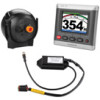Garmin GHP 20 Marine Autopilot System for Yamaha Helm Master Installation Inst - Page 12
About the Sea Trial Wizard, Important Sea Trial Wizard Considerations
 |
View all Garmin GHP 20 Marine Autopilot System for Yamaha Helm Master manuals
Add to My Manuals
Save this manual to your list of manuals |
Page 12 highlights
About the Sea Trial Wizard The Sea Trial Wizard configures the fundamental sensors on the autopilot, and it is extremely important to complete the wizard in conditions appropriate for your boat. Important Sea Trial Wizard Considerations Complete the Sea Trial Wizard in calm water. The nature of calm water is relative to the size and shape of your boat. • Ensure your boat does not rock while sitting still or moving very slowly. • Ensure your boat is not significantly affected by the wind. • Keep the weight on your boat balanced. DO NOT move around on the boat while completing any of the steps in the Sea Trial Wizard. Starting the Sea Trial Wizard Before you start the Sea Trial Wizard, you must drive to an open area of calm water. 1. Turn on the GHP 20. 2. Select an option: • If the Sea Trial Wizard starts automatically, proceed to step 3. • If the Sea Trial Wizard does not start automatically, select Menu > Setup > Dealer Autopilot Configuration > Wizards > Sea Trial Wizard. 3. Select Begin. Performing the Sea Trial Wizard 1. Drive your boat to an open area of calm water. 2. Start the Sea Trial Wizard (page 12). 3. Configure the planing RPM (page 12). 4. Calibrate the compass (page 12). 5. Perform the autotune procedure (page 12). 6. Set north (page 12). 7. If necessary, set the fine heading adjustment (page 12). Configuring the Planing RPM 1. Note the RPM reading from the tachometer on the dashboard of your boat at the point your boat transitions from displacement to planing speed. 2. If the tachometer value does not match the value on the GHC 20, use the arrows to adjust the value. 3. Select Done. Calibrating the Compass 1. Drive your boat at slow/idle speed in a straight line. 2. Select Begin, and continue to drive in a straight line. 3. When instructed, turn the boat slowly clockwise, taking care to make the turn as steady and flat as possible. Turn slowly so that the boat DOES NOT list. The GHC 20 displays a completion message when the calibration is complete. 4. Select an option: • If the calibration completes successfully, select Done. • If the calibration fails, select Retry and repeat steps 1-3. Performing the Autotune Procedure Before you can perform the autotune procedure, you must have a large stretch of open water available. 1. Adjust the throttle so the boat travels below planing speed. 2. Select Begin. The boat performs a number of zigzag motions while the Autotuning is in progress. The GHC 20 displays a completion message. 3. Select an option: • If the autotune completed successfully, select Done and take manual control of the boat. • If the autotune failed, adjust the throttle and select Retry Autotune. 4. If autotune fails, repeat steps 1-3 until the autotune completes successfully. 5. If the autotune procedure continues to fail after you reach maximum cruising speed, reduce your speed to the initial autotune speed and select Alternate Autotune to begin an alternate autotuning procedure. Setting North Before you can set north, you must have at least 45 seconds of hazardfree, open water available. This procedure appears only if you connect an optional GPS device to the GHP 20 (page 10), and the device has acquired a GPS position. If you do not have a GPS device connected, you are prompted to set the fine heading adjustment (page 12). 1. Drive the boat in a straight line at cruising speed, parallel to the prevailing wind and current, for 45 seconds. 2. Select Begin. 3. Select an option: • If the calibration completed successfully, select Done. • If the calibration failed, repeat steps 1-2. Setting the Fine Heading Adjustment This procedure appears only if you do not have an optional GPS device connected to the GHP 20 (page 10). If you do have a GPS device installed on your boat that has acquired a GPS position, you are prompted to set north instead (page 12). 1. Using a handheld compass, identify north. 2. Adjust the fine heading setting until it matches north on the magnetic compass. 3. Select Done. Evaluating the Results of the Autopilot Configuration 1. Test the autopilot at a slow speed. 2. If necessary, adjust the gain setting (page 13). 3. Test the autopilot at a higher speed (normal operating conditions). 4. If necessary, adjust the gain and acceleration limiter settings. Testing and Adjusting the Autopilot Configuration 1. Drive the boat in one direction with the autopilot engaged (heading hold). The boat should not oscillate significantly; however, a small amount of oscillation is normal. 12 GHP 20 Installation Instructions















